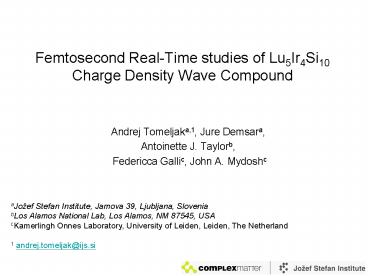Femtosecond RealTime studies of Lu5Ir4Si10 Charge Density Wave Compound - PowerPoint PPT Presentation
1 / 16
Title:
Femtosecond RealTime studies of Lu5Ir4Si10 Charge Density Wave Compound
Description:
Femtosecond Real-Time studies of Lu5Ir4Si10 Charge Density Wave Compound. Andrej Tomeljaka,1, Jure Demsara, Antoinette J. Taylorb, Federicca Gallic, John A. Mydoshc ... – PowerPoint PPT presentation
Number of Views:29
Avg rating:3.0/5.0
Title: Femtosecond RealTime studies of Lu5Ir4Si10 Charge Density Wave Compound
1
Femtosecond Real-Time studies of Lu5Ir4Si10
Charge Density Wave Compound
- Andrej Tomeljaka,1, Jure Demsara,
- Antoinette J. Taylorb,
- Federicca Gallic, John A. Mydoshc
aJoef Stefan Institute, Jamova 39, Ljubljana,
Slovenia bLos Alamos National Lab, Los Alamos,
NM 87545, USA cKamerlingh Onnes Laboratory,
University of Leiden, Leiden, The Netherland 1
andrej.tomeljak_at_ijs.si
2
CDW materials
- Modulation of the charge density
- Occurrence in low dimensional solids
- Nesting of the Fermi surface
- Energy gap in the single particle excitation
spectrum
3
Motivation
YBa2Cu3O6.9
J.Demsar et al., Phys. Rev. B. 61, 1477 (2000).
J.Demsar et al., Phys. Rev. Lett. 83, 800 (1999).
K0.3MoO3
4
Lu5Ir4Si10
- TCDW 83 K
- Strong interchain coupled system with first order
CDW transition - Only partial gapping of the Fermi surface
- Weak CDW effect
- Superconducting at T lt 3.9 K.
B. Becker et al., Phys. Rev. B 59, 72667269
(1999).
5
Experiment
probe
E
excitation
Dt
sample
CDW
c
a
6
Experiment
E
Dt
probe
sample
excitation
CDW
c
a
7
Femtosecond time resolved spectroscopy
- Observation of reflectivity relaxation after
short laser pulse (20 fs) excitation. - Initial relaxation of the material within 10-100
fs. - Further relaxation depends strongly on the low
lying electron spectrum. - The technique very sensitive to the opening of a
gap in the single particle excitation spectrum
8
Experimental details
- Small signals ?R/R 10-6
- Averaging, mode-locking the signals
- Linear regime
- Heating due to laser illumination estimated to
20 K and accounted for
9
(No Transcript)
10
Offset
Calculated data from Tediosi et al., to be
published.
11
Offset
Calculated data from Tediosi et al., to be
published.
12
Oscillations
13
Oscillations
14
Oscillations
K0.3MoO3
1T-TaS2
2H-TaSe2
J. Demsar et al., Phys. Rev.B 66, 041101(R)
(2002).
J.Demsar et al., Phys. Rev. Lett. 83, 800 (1999).
15
Picosecond component
16
Picosecond component
Groeneveld et al, Phys. Rev. B 51, 11433 (1995).
17
Picosecond component
J. Demar et al.
18
Picosecond component
2D 400 K
J. Demar et al.
19
Conclusions
- First studies of carrier relaxation dynamics in
Lu5Ir4Si10 - Despite the small changes in the low energy
electronic structure (change in resistivity only
30) and metallic behavior at low T, signatures
of CDW modulation are observed in real time
dynamics response. - The long nanosecond dynamics can be explained in
terms of bolometric response - Oscillatory component (strongly damped) is
attributed to the amplitude mode of the CDW - The picosecond decay dynamics shows anomalous
temperature dependence below TCDW. The behavior
is consistent with the relaxation across the CDW
gap. The gap magnitude was estimated to be 2D
400K 35 meV.
20
(No Transcript)
21
J. B. Betts et al., Phys. Rev. B 66, 060106(R)
(2002)
22
Lu5Ir4Si10
Y.-K. Kuo et al., Phys. Rev. B 67, 195101 (2003).
Y.-K. Kuo et al., Phys. Rev. B 67, 195101 (2003).
23
Lu5Ir4Si10
J. B. Betts et al., Phys. Rev. B 66, 060106(R)
(2002)
B. Becker et al., Phys. Rev. B 59, 72667269
(1999).
24
References
- J.Demsar et al., Phys. Rev. Lett. 83, 800 (1999).
- J.Demsar et al., Phys. Rev. B. 61, 1477 (2000).
- J. B. Betts et al., Phys. Rev. B 66, 060106(R)
(2002). - Y.-K. Kuo et al., Phys. Rev. B 67, 195101 (2003).
- B. Becker et al., Phys. Rev. B 59, 72667269
(1999). - H. F. Braun, Acta Crystallogr., Sect. B Struct.
Crystallogr. Cryst. Chem. 36, 2397 (1980) J.
Less-Common Met. 100, 105 (1984). - J. Demsar et al., Phys. Rev.B 66, 041101(R)
(2002).
25
Experimental details
- Laser Mode-locked Ti-sapphire
- 800 nm (1.55 eV)
- 20 fs pulses
- 80 MHz repetition
- 70 (30) µm pump (probe) focus
- Lock-in with 100 kHz modulation
- Pump (probe) power 30 (2) mW ? excitation
density j 40 µJ/cm2.































